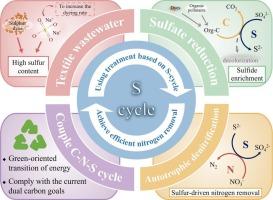Sulfur cycle, a new opportunity for nitrogen removal from textile wastewater: A review
IF 6.3
2区 工程技术
Q1 ENGINEERING, CHEMICAL
引用次数: 0
Abstract
The problem of nitrogen removal from textile wastewater (TW) has plagued for quite a long time. Traditional biological nitrogen removal technology is limited by the complex water quality characteristics, and high concentration of sulfate (over 5000 mg/L) further aggravates its difficulty. After analyzing source and characteristics of nitrogen and sulfur in TW, using miraculous sulfur cycle caused by the existing sulfate to solve the problem of nitrogen removal seems to be a viable option. This review mainly elaborated the heterotrophic sulfate reduction combining with dye removal, which achieved >90 % sulfate reduction and almost complete dye removal, as well as sulfur-driven autotrophic denitrification, with over 85 % total nitrogen removal. The crucial bacteria and key parameters affecting sulfur cycle were summarized. Based on the characteristics of abundant sulfur and nitrogen in TW, the feasibility of relying on sulfur cycle to achieve nitrogen removal in TW is discussed in detail. Furthermore, the sulfur and nitrogen coupled processes, including sulfate reduction, autotrophic denitrification and nitrification integrated process (SANI) and Sulfammox are reviewed. Technology based on sulfur cycle has the advantages of low energy consumption and low sludge production (reduce by 90 %), as well as cutting greenhouse gas emissions (decrease by 90 %). In the context of carbon peaking and carbon neutrality goals, TW treatment based on sulfur cycle is an energy-saving and carbon-reduction technology with development potential.

硫循环--纺织废水脱氮的新机遇:综述
纺织废水(TW)的脱氮问题困扰已久。传统的生物脱氮技术受限于复杂的水质特性,而高浓度的硫酸盐(超过 5000 mg/L)更加剧了其难度。在分析了 TW 中氮、硫的来源和特性后,利用现有硫酸盐引起的神奇硫循环来解决脱氮问题似乎是一个可行的选择。本综述主要阐述了与染料去除相结合的异养硫酸盐还原法,其硫酸盐还原率达到 90%,染料去除率几乎达到100%;以及硫驱动的自养反硝化法,其总脱氮率超过 85%。总结了影响硫循环的关键细菌和关键参数。根据 TW 中硫氮丰富的特点,详细讨论了依靠硫循环实现 TW 脱氮的可行性。此外,还综述了硫氮耦合过程,包括硫酸盐还原、自养反硝化和硝化综合过程(SANI)和硫氨氧化。基于硫循环的技术具有能耗低、污泥产量低(减少 90%)以及减少温室气体排放(减少 90%)的优点。在碳峰值和碳中和目标的背景下,基于硫循环的 TW 处理技术是一种具有发展潜力的节能减碳技术。
本文章由计算机程序翻译,如有差异,请以英文原文为准。
求助全文
约1分钟内获得全文
求助全文
来源期刊

Journal of water process engineering
Biochemistry, Genetics and Molecular Biology-Biotechnology
CiteScore
10.70
自引率
8.60%
发文量
846
审稿时长
24 days
期刊介绍:
The Journal of Water Process Engineering aims to publish refereed, high-quality research papers with significant novelty and impact in all areas of the engineering of water and wastewater processing . Papers on advanced and novel treatment processes and technologies are particularly welcome. The Journal considers papers in areas such as nanotechnology and biotechnology applications in water, novel oxidation and separation processes, membrane processes (except those for desalination) , catalytic processes for the removal of water contaminants, sustainable processes, water reuse and recycling, water use and wastewater minimization, integrated/hybrid technology, process modeling of water treatment and novel treatment processes. Submissions on the subject of adsorbents, including standard measurements of adsorption kinetics and equilibrium will only be considered if there is a genuine case for novelty and contribution, for example highly novel, sustainable adsorbents and their use: papers on activated carbon-type materials derived from natural matter, or surfactant-modified clays and related minerals, would not fulfil this criterion. The Journal particularly welcomes contributions involving environmentally, economically and socially sustainable technology for water treatment, including those which are energy-efficient, with minimal or no chemical consumption, and capable of water recycling and reuse that minimizes the direct disposal of wastewater to the aquatic environment. Papers that describe novel ideas for solving issues related to water quality and availability are also welcome, as are those that show the transfer of techniques from other disciplines. The Journal will consider papers dealing with processes for various water matrices including drinking water (except desalination), domestic, urban and industrial wastewaters, in addition to their residues. It is expected that the journal will be of particular relevance to chemical and process engineers working in the field. The Journal welcomes Full Text papers, Short Communications, State-of-the-Art Reviews and Letters to Editors and Case Studies
 求助内容:
求助内容: 应助结果提醒方式:
应助结果提醒方式:


